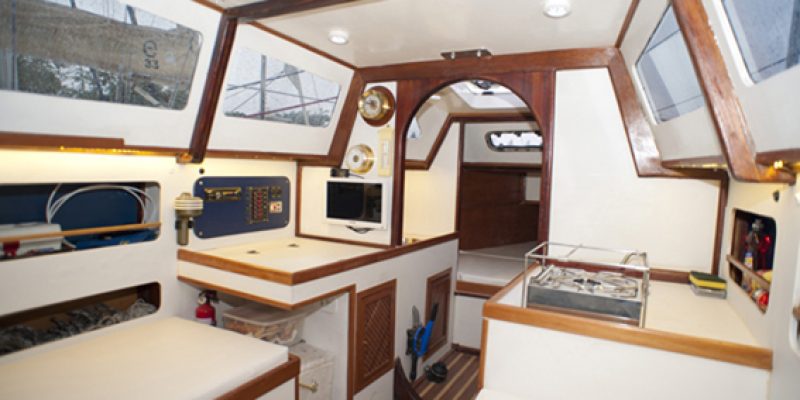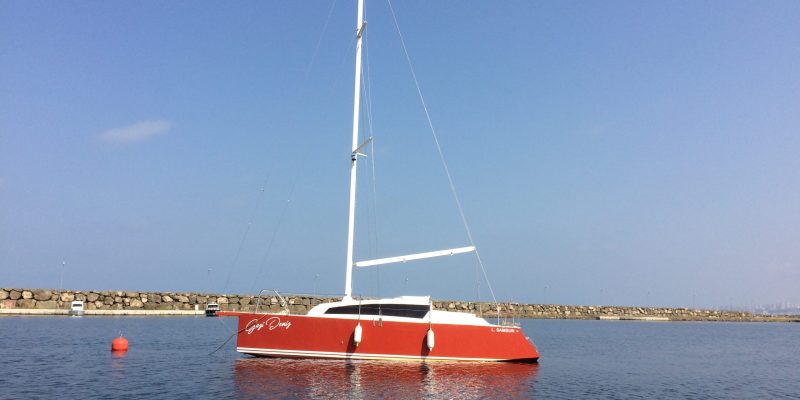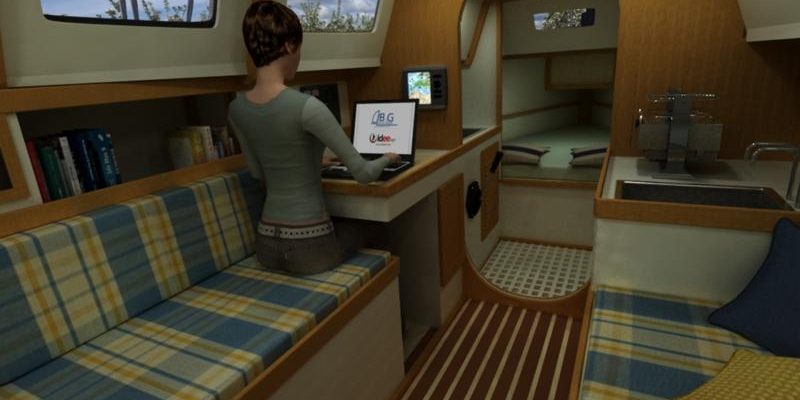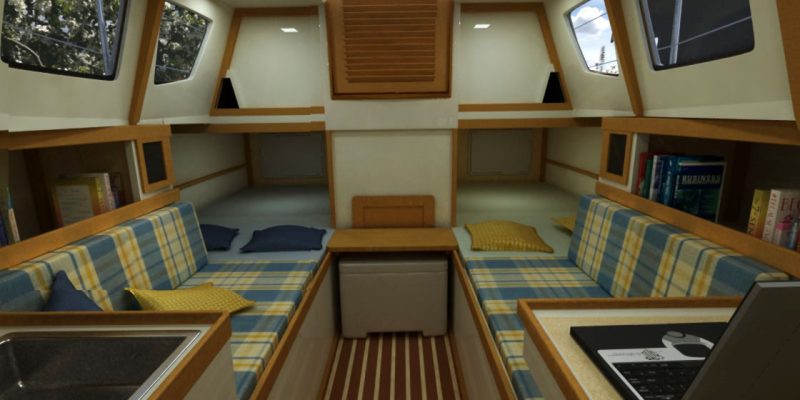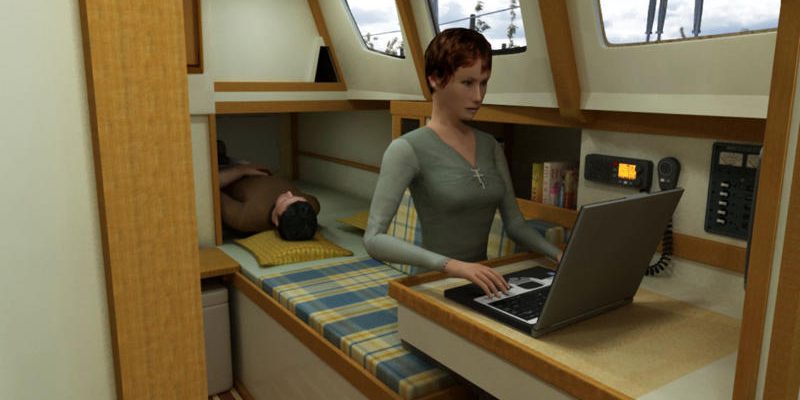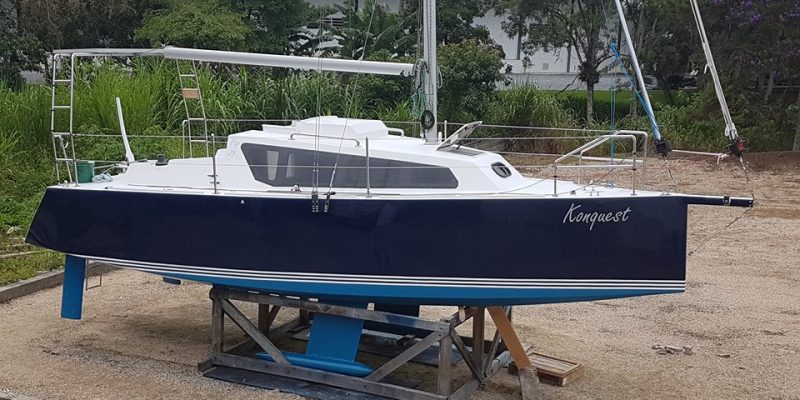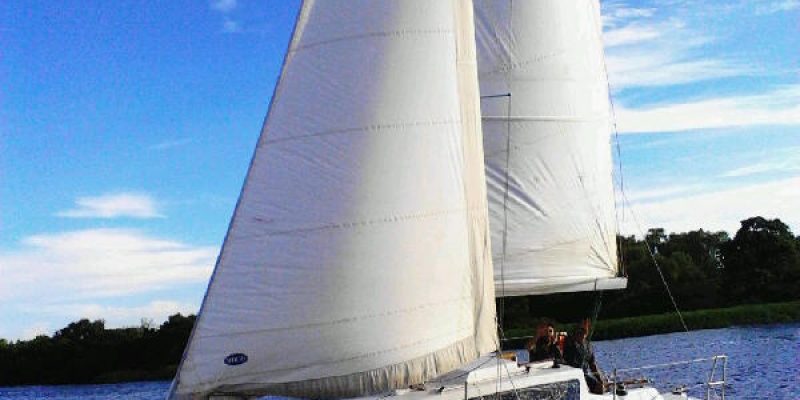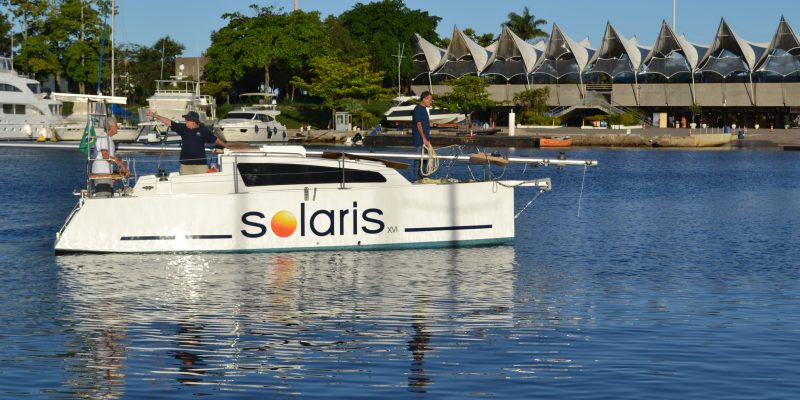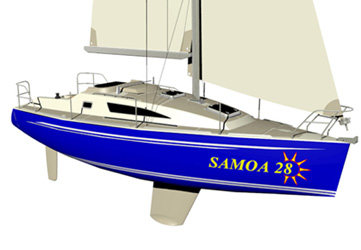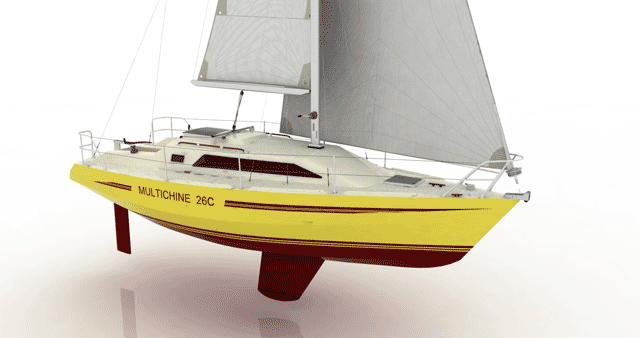Boat Plans - Pop 25
Easy to build cruising sailboat with modern shape and functional concept.
The Pop 25 is cruising sailboat with modern shape, functional concept and ideal for those aspiring sustainability in carbon emissions. Its lines show a collection of new trends in the field of yacht design, such as close to triangular beam distribution, twin keels and rudders, no backstay and vertical topsides.
Intended for amateur construction, the Pop 25 is extremely simple to be built. It’s cost of construction is also comparatively low since its construction specifications cater for easy to find and affordable materials. A special plywood/epoxy construction technique is intended for the amateur builder, even for those with no previous experience, requiring almost only hammer and nails for the hull to be assembled.
The Pop 25 is designed for offshore sailing and for that purpose is structurally very robust. One of the most important features of the Pop 25 is the fact that it is virtually unsinkable, with positive buoyancy provided by the foam-filled sealed compartments together with double walled topsides and superstructure.
Primarily specified to have electric auxiliary propulsion installed, the Pop 25 is environmentally friendly, since it does not require a single drop of hydrocarbon fuels to propel her. The motor works as a generator when the boat is under sail and the propeller runs free, which together with the assistance of solar panels and wind generator, provide energy for all required appliances on board.
Long distance sailing autonomy is assured by two hundred and sixty litres of freshwater capacity carried in two separate tanks as well and two integrated holding tanks with sixteen litres capacity each.
Technical Data
Length Overall
7.54 m (24′ 8″)
Length Waterline
7.25 m (23′ 10″)
Beam
2.80 m (9′ 2″)
Draft
1.10 m (3′ 7″)
Ballast
560 kg (1230 lb)
Displacement (light)
2800 kg (6330 lb)
Fresh water tanks
260 l (68 gl)
Standing Headroom
1.80 m (5′ 11″)
Rig Type
Sloop
Sail Area
44 m2 (293 sq ft)
Auxiliary Propulsion
4.5 kW (electric motor)
Construction
Plywood/epoxy
List of Plans
POP25 – S1 – Lines Plan
POP25 – S2 – Mast and Sails
POP25 – S3 – Interior Layout
POP25 – S4 – Deck Layout
POP25 – S5A – Structural Plan A
POP25 – S5B – Structural Plan B
POP25 – S5C – Structural Plan C
POP25 – S6A – Transverse Section A
POP25 – S6B – Transverse Section B
POP25 – S6C – Transverse Section C
POP25 – S6D – Transverse Section D
POP25 – S6E – Transverse Section E
POP25 – S6F – Cutting at Stations
POP25 – S6G – Deck Beams Full Size
POP25 – S7 – Keel
POP25 – S8 – Rudder
POP25 – S8B – Tiller
POP25 – S8C – Rudder Panels
POP25 – S9 – Custom Fittings
POP25 – S10 – Sliding Hatch
POP25 – S11 – Stem
POP25 – S12A – Engine Install
POP25 – S12B – Engine Install Saildrive
POP25 – S12C – Access Door
Boat Description
This fore cabin is nearly triangular in shape and it comprises of a double berth, more adequate to be used when in port. The space in the central area under the bunk-boards is a storage compartment. Two integrated holding tanks are built at each side of this central space, the rest of the volume under the berth being foam filled reserve buoyancy.
The heads, placed between bulkheads 3 and 4, goes from side to side, what improves the feeling of spaciousness. Privacy may be obtained by means of curtains. The corridor between toilet and vanity basin is strategically positioned under the fore-hatch with the intention of improving ventilation and headroom. An opening port installed in the cabin trunk front wall also contributes for airing this area of the boat.
The galley is placed at starboard between stations 4 and 5. On its counter, close to Station 4, is installed a one burner stove (Domestic Environmental non-pressurized alcohol stove suggested, since it is our intention to specify an ecologically correct cooking fuel), which we recommend being gimbaled and provided with potholders. The sink is placed abaft the stove, having fresh and saltwater sprouts. Water is supplied by means of foot pumps.
There is a bin behind the stove and sink, and another one under the counter, both for kitchen’s appliances.
The navigation table is fitted on the opposite side to the galley counter. It is also provided with a locker placed next to the topside of the hull, intended for the installation of the VHF and electrical system panel.
There is a chart locker under the table with access from upside. Under the fore half of this chart locker there is a bin accessed by a door placed on its front-wall. The dustbin is attached on hooks to the inside face of this door. This is very handy, since it is only a matter of opening the door to throw anything in it, and when emptying is required, it is just removing the whole dustbin from its hooks.
There is a watertight niche a t the aft lower corner of the bin where the automatic bilge pump is installed
The second half of the space below the chart locker is open and is intended to allow the navigator to sit with his body facing forward fitting his legs under the table. This allows installing a chart-plotter or multi-function display at the aft face of the Station 4 bulkhead, giving frontal vision to the navigator in the bow’s direction.
The social area of the interior stays abaft the galley and navigation table. It is constituted of two symmetrical sofas measuring 900mm in length each, being the right size for two persons to sit comfortably side by side. Under the sofas’ seats, going from Station 5 to Station 6, there is an ample compartment, a convenient place to store provisions. In that same spot the fin-keel arms cross the hull-bottom panel and are attached to Station 5 bulkhead by means of two angle bars.
Behind the two seat backrests are placed lockers accessed by doors installed in the backrest panels, which are hidden behind the backrest cushions. Above these lockers there is a bookshelf on each side. This furniture is an extension of the galley and navigation table lockers. There is a locker with hinged door abaft Station 5, measuring 200mm, fore and aft.
The two quarter-berths, measuring 1.90m x 1.08m, are placed abaft the sitting area of the cabin and are extensions of them. Both are wide enough for a couple to sleep in them comfortably. Being locked between the cockpit wall and the topsides, they are ideal to be used when underway, since there isn’t the possibility of falling off in case of jerks when the boat is lurching heavily when sailing in bad weather. The 130 litres integrated freshwater tanks are built inside the compartments under them. Abaft Station 7 are installed the two 300Ah battery banks intended to provide energy for auxiliary propulsion and all other appliances onboard. The spare room inside those ample lockers is intended for equipment storage
Abaft Station 9 bulkhead, at the same level of bunk-boards, there are two compartments with access through openings in the bulkheads, ideal for storage of linen and heavy cold weather clothing. The plans specify the installation of water-tight hatches on the access openings, to make these two bins non-floodable. The space under these bins is foam-filled, representing part of the sealed compartments which turn the Pop 25 virtually unsinkable. The others are placed under the cockpit sole between station 9 and Station 10, besides three foam filled boxes under the fore bunk, the core of the boarding platform, and the double-walled topsides, deck and coach-roof cores.
The 600mm wide corridor extends from Station 3 to Station 8. Between Stations 3 and 4 it makes the heads floor, and from station 4 to station 7 it forms the circulation area of the cabin. One peculiarity of the Pop 25 is that it doesn’t require floorboards. Since there are no frame floors neither fin-keel bolts to attach in bilges, the suppression of this piece enhances headroom and cuts time and cost of construction. The boat is so leak-proof that we feel confident in taking this decision. Maximum headroom is 1.80m under the companionway hatch in shut position, a strategic place to dress a wet suit without requiring performing antics for the purpose.
Just under the companionway hatch is placed a sliding stool which serves as entrance step and when it slides forwards it makes a convenient seat when working in the galley. The cooler-box is stowed under it at the companionway hatch entrance. There is no risk of a fall when the stool is removed from its original place. since the cooler-box lid also performs the role of a back-up step. Abaft Station 7, under the cockpit floor, this central area is the auxiliary motor compartment.
The Pop 25 plumbing is a piece of cake to be made. The number of components is very small and installation is within the reach of the most inexperienced amateur builder. It consists of two integrated fresh-water tanks, two sinks, a toilet, two holding tanks and two bilge pumps, one electric and the other manual. The whole installation is either in the open, or it is of easy access, an assurance of long-lasting trouble-free usage. This simplicity means giving up a higher level of sophistication, like pressurized running water, for instance. However, there is no restriction if a pressurized system is preferred, since there is room enough for the installation of a pressurized electric pump.
On the other hand, the electrical installation is a more powerful system on board. Since the auxiliary propulsion suggested is electrical, the motor requires a 600Ah battery bank to provide a long range of operation. Fortunately, the batteries also perform the role of inside ballast, and where they are stored, just on top of the fin-keels, they hardly represent a bulky package. Apart from the auxiliary propulsion, most other appliances suggested are low consuming, like LED lights and digital electronics, not being recommended electrical refrigeration or any other power-thirsty equipment. Energy is re-stored at sea by means of solar panels placed in a gantry, wind generator and by the electric motor itself, which becomes a generator when the boat is under sail.
The cabin trunk was designed to provide maximum headroom without jeopardizing aesthetics and performance.
The cockpit is ample and functional. The helmsman sits in the widest area of the tee-shaped cockpit at an arm’s length from the main-sheet and traveller control, while at the same time he/she can be positioned to windward, enhancing stability and visibility.
Installing a canvas dodger embracing the cockpit seats next to the cabin aft wall provides good shelter for the crew when sitting there and allows opening the companionway hatch when the boat is sailing close-hauled.
The high cockpit coaming, together with the embracing protection of the dodger, transmits a sensation of cosiness to be praised by any cruising sailor.
The side-deck is sufficiently wide to allow easy passage to the foredeck, even though very little manoeuvre is required at the forepeak. Foresails are stored rolled around their foils and the furling lines are controlled from the cockpit. Eventually a whisker-pole may be attached to the jib or Yankee clews.
Another feature to be praised is the large transom platform. This stern scoop is wide enough to allow two persons to sit on it with room to spare, and on its starboard side is stored the swimming ladder. The low, convex, platform transom (Station 10.7) is beefed up at centre-line making a strong point for the attachment of a self-steering gear. The deck is particularly uncluttered. The Yankee sheet leads to a fixed point placed in an interruption of the toe-rail. From there the sheet passes through a stopper and goes straight to the sheet winch installed in the coaming. The jib sheet passes through a fairlead, a necessary feature, since the jib may be reefed to the size of a storm jib, requiring the fairlead to be moved forward on its rail.
The deck arrangement is so much stripped of unnecessary gear that sailing single-handed aboard the Pop 25 is a task for an inexperienced sailor to accomplish.
The Pop 25 can rest upright on its twin keels when aground in a flat surface, being the two fin-keels authentic sledges to keep it upside.
The Pop 25 twin keels are made in an unusual way. They consist of two 20mm (3/4”) steel plates, custom cut to shape, either by CNC file, or by traditional methods, with their leading and trailing edges grinded to shape. Under their lower tips are welded two torpedo shaped steel bulbs tailored in a mechanical lathe. This is a cheap and easy way to make these appendices, since the steel material and workmanship to produce the pieces are easily found anywhere. Stability is enhanced by the battery banks, which in the case of the Pop 25, are considered internal ballast.
The keels are fixed to the hull in a unique way; the fin-keels are flanged at hull bottom level and theses flanges are bolted to the plywood laminated structural keel of the boat. However, the plates surpass the hull bottom protruding internally to almost the height of the saloon seat-boards. The fore sides of the plates are joined to Station 5 bulkhead by means of two angle bars. This is the strongest and most trouble-free way to attach a fin-keel to a hull one can find in any sailboat.
The two rectangular balanced spade rudders are built bonding plywood panels in layers and then fairing the plywood blocks. The rudder stocks are made of S.S. 40mm round bars with two flat bars that work as hinges welded to their immersed parts aft side. The rudder stock tubes run inside boxes built in place abaft the transom. The whole system is slightly over-dimensioned making the rudders virtually indestructible. This is advisable since the rudders may have to support a large amount of the boat’s weight, if when grounding in an irregular bottom they must support the stern part of the boat. Independent of this strength margin, the rudder blades still are encapsulated in fiberglass, as the whole outside surface of the boat is. Being also over-dimensioned in area they ensure rudder control no matter the sea conditions are.
We are betting our chips that most sailboats will have electric motors for auxiliary propulsion installed in the near future. Burning hydrocarbon fuels is an unsustainable attitude in the long run, and people concerned with the ecology will want to avoid contributing to poisoning the atmosphere with carbon monoxide.
The sun provides us with inexhaustible amounts of non-polluting energy, being a praiseworthy endeavour learning to take advantage of this.
Electric auxiliary propulsion is already a reality as far as sailboats are concerned, even though with some limitations so far. The efficiency of the electric motors outstands that of explosion engines in an 85/90% efficiency ratio to 35%, or so. Besides electric motors are silent, require virtually no maintenance and can generate energy when the boat is under sail. On the other hand, the density of energy stored in hydrocarbon fuels, at the state of the art, may be as much as one hundred times larger than electricity.
The Pop 25 requires at least a 4.5 kW electric motor to be propelled at five knots or more. For six to eight hours of continuous operation, with a motor of this working power installed, it requires a battery bank of at least 600Ah If the boat is meant to be sailed on short weekend trips and is stationed in a marina where energy can be supplied from the city’s A.C. system, then there will probably be low risk of getting battery banks flat. If, however, the boat is intended for longer passages, it will require its own means of replenishing the energy supply, like solar panels, wind generator, the motor itself functioning as generator when the boat is sailing, or even by complementing an eventual deficit of supply with a small portable generator.
There are several companies in the US and Europe producing electric motors for small sailboats auxiliary propulsion. Among them, OZmarine, from Sweden, has in its line of products a model that suits well the Pop 25, the OZsingle 4.5kW motor. Another option is the Thoosa 6000, 6kW, produced by Asmo Marine, from Denmark. Even though being a little over-dimensioned, with its 6kW, it affords a higher speed with a proportional increase in consumption.
There are, however, many other suppliers of small electric DC motors intended for small craft propulsion, especially in the United States. Notwithstanding, for those who still would prefer the familiarity afforded by the conventional diesel engine, there is no restriction in installing a compact engine in the 10hp range. Alternatively, an outboard motor, electric or not, could be an acceptable choice for the Pop 25.
Browse Gallery
See Related Plans


